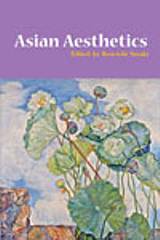Home > Book Detail Page

While the artistic traditions of the various countries of East, Southeast and South Asia display distinctive aesthetic features, this volume examines the qualities of each area, and seeks commonalities that define the aesthetics of a broader Asian civilisation. Contributors include specialists in philosophy, literature, art history, religion and the comparative study of cultures. Some of them are writing from within their own cultural traditions while others approach their subjects as outside observers.
The book is divided into five sections, dealing with Japanese, Korean, Chinese, Indian and Southeast Asian aesthetics. Individual chapters provide in-depth investigations of specific traditions, embracing both classical as well as modern aesthetic forms. The authors suggest that Japanese culture is characterised by an openness to diverse cultural influences, Korean culture by “peninsularity”, Chinese culture by parallels with the West, Indian culture by “rasa” (a kind of “cosmic” feeling that is distinct from the one who feels), and Southeast Asian culture by dilemmas of modernisation. The volume as a whole integrates these studies, clarifying essential elements of each aesthetic culture and drawing on this material to characterise an Asian civilization that transcends individual countries and cultures.
The book is divided into five sections, dealing with Japanese, Korean, Chinese, Indian and Southeast Asian aesthetics. Individual chapters provide in-depth investigations of specific traditions, embracing both classical as well as modern aesthetic forms. The authors suggest that Japanese culture is characterised by an openness to diverse cultural influences, Korean culture by “peninsularity”, Chinese culture by parallels with the West, Indian culture by “rasa” (a kind of “cosmic” feeling that is distinct from the one who feels), and Southeast Asian culture by dilemmas of modernisation. The volume as a whole integrates these studies, clarifying essential elements of each aesthetic culture and drawing on this material to characterise an Asian civilization that transcends individual countries and cultures.
Ken-ichi Sasaki is Professor of Aesthetics at Nihon University in Tokyo and Professor Emeritus at the University of Tokyo.
Preface
Ken-ichi Sasaki
Acknowledgements
Part I Japanese Aesthetics
Chapter 1 Introduction
Ken-ichi Sasaki
Chapter 2 Subject of the Absence and Absence of the Critique
Megumi Sakabe
Chapter 3 Japanese Philosophy in the Magnetic Field between Eastern and Western Languages
Ken-ichi Iwaki
Chapter 4 Art Outside Life and Art as Life
Akira Amagasaki
Chapter 5 The Aesthetics of Tradition: Making the Past Present
Michael F. Marra
Chapter 6 Another Aesthetics of the Image and/or the Utopia of Aesthetics
Keiji Asanuma
Part II Korean Aesthetics
Chapter 7 Introduction: Meot — In Search of Korean Aesthetic Identity
Ynhui Park
Chapter 8 On the Debate about the Colour White
Ihn-Bum Lee
Chapter 9 The Aesthetic Identity of Hangeul Calligraphy
Hunyee Jung
Chapter 10 The Aesthetics of the Plural Korean Essence
Frédéric Boulesteix
Part III Chinese Aesthetics
Chapter 11 Introduction: From the Classical to the Modern
Gao Jianping
Chapter 12 Several Inspirations from Traditional Chinese Aesthetics
Ye Lang
Chapter 13 The Theoretical Significance of Painting as Performance
Gao Jianping
Chapter 14 A Study in the Onto-Aesthetics of Beauty and Art: Fullness (chongshi) and Emptiness (kongling) as Two Polarities in Chinese Aesthetics
Cheng Chung-ying
Chapter 15 On the Modernisation of Chinese Aesthetics
Peng Feng
Chapter 16 Reflections on Avan-tgarde Theory in a Chinese-Western Cross-cultural Context — or an Amateur Attempt in Metatheory
Karl-Heinz Pohl
Part IV Indian Aesthetics
Chapter 17 Introduction to Indian Aesthetics
Grazia Marchianò
Chapter 18 What is Meant by “Art” in India — Western Misunderstandings
Chantal Maillard
Chapter 19 Ownerless Emotions in Rasa-Aesthetics
Arindam Chakrabarti
Chapter 20 On the Western Reception of Indian Aesthetics — the Grounds of Difference
Robert Wilkinson
Chapter 21 Transcultural Aesthetics: Schopenhauer and Tagore
R. Raj Singh
Part V Southeast Asian Aesthetics
Chapter 22 Introduction to the Aesthetics of Southeast Asia
David Chou-Shulin
Chapter 23 Traditional Thai Buddhist Art and Modern Challenges
Suwanna Satha-Anand
Chapter 24 Poetry, Identity, and Social Modernisation
Lin Sheng-Bin
Chapter 25 Southeast Asia: Modern, Postmodern, or Premodern?
David Chou-Shulin
Contributors
Index
Ken-ichi Sasaki
Acknowledgements
Part I Japanese Aesthetics
Chapter 1 Introduction
Ken-ichi Sasaki
Chapter 2 Subject of the Absence and Absence of the Critique
Megumi Sakabe
Chapter 3 Japanese Philosophy in the Magnetic Field between Eastern and Western Languages
Ken-ichi Iwaki
Chapter 4 Art Outside Life and Art as Life
Akira Amagasaki
Chapter 5 The Aesthetics of Tradition: Making the Past Present
Michael F. Marra
Chapter 6 Another Aesthetics of the Image and/or the Utopia of Aesthetics
Keiji Asanuma
Part II Korean Aesthetics
Chapter 7 Introduction: Meot — In Search of Korean Aesthetic Identity
Ynhui Park
Chapter 8 On the Debate about the Colour White
Ihn-Bum Lee
Chapter 9 The Aesthetic Identity of Hangeul Calligraphy
Hunyee Jung
Chapter 10 The Aesthetics of the Plural Korean Essence
Frédéric Boulesteix
Part III Chinese Aesthetics
Chapter 11 Introduction: From the Classical to the Modern
Gao Jianping
Chapter 12 Several Inspirations from Traditional Chinese Aesthetics
Ye Lang
Chapter 13 The Theoretical Significance of Painting as Performance
Gao Jianping
Chapter 14 A Study in the Onto-Aesthetics of Beauty and Art: Fullness (chongshi) and Emptiness (kongling) as Two Polarities in Chinese Aesthetics
Cheng Chung-ying
Chapter 15 On the Modernisation of Chinese Aesthetics
Peng Feng
Chapter 16 Reflections on Avan-tgarde Theory in a Chinese-Western Cross-cultural Context — or an Amateur Attempt in Metatheory
Karl-Heinz Pohl
Part IV Indian Aesthetics
Chapter 17 Introduction to Indian Aesthetics
Grazia Marchianò
Chapter 18 What is Meant by “Art” in India — Western Misunderstandings
Chantal Maillard
Chapter 19 Ownerless Emotions in Rasa-Aesthetics
Arindam Chakrabarti
Chapter 20 On the Western Reception of Indian Aesthetics — the Grounds of Difference
Robert Wilkinson
Chapter 21 Transcultural Aesthetics: Schopenhauer and Tagore
R. Raj Singh
Part V Southeast Asian Aesthetics
Chapter 22 Introduction to the Aesthetics of Southeast Asia
David Chou-Shulin
Chapter 23 Traditional Thai Buddhist Art and Modern Challenges
Suwanna Satha-Anand
Chapter 24 Poetry, Identity, and Social Modernisation
Lin Sheng-Bin
Chapter 25 Southeast Asia: Modern, Postmodern, or Premodern?
David Chou-Shulin
Contributors
Index











